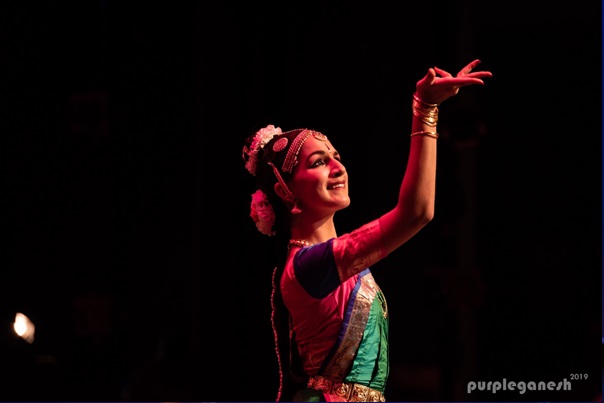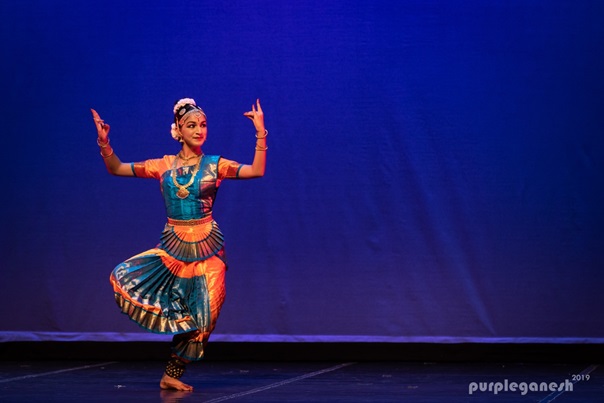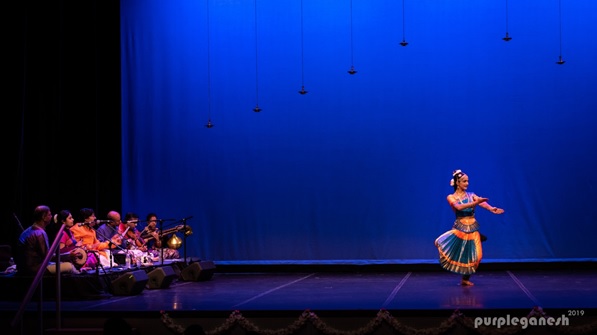Contribute
| Arangetram: Divya Natarajan |
Leela Raja
09/04/2019
Local Boston Flavor a Treat “Takita taka dhimi…ta din gina tom…†the rhythms of what is to me the most beautiful dance style in the world, Bharatanatyam – one of the oldest dance traditions in the world. But, of course, it would be for a former professional South Indian classical dancer who performed Bharatanatyam and Kuchipudi globally for nearly four decades. I write this article with the rhythms and melodies of Bharatanatyam in my mind and heart, just having witnessed the lovely debut performance (arangetram) of Divya Natarajan, the 16-year-old daughter of a long-time friend. She is the student of Guru Deepa Srinath-Bungale of Vaibhava Dance School. The performance took place at the Sorenson Center for the Arts Theater, Babson College, in Wellesley, Massachusetts, on Saturday, 10 August 2019. The Bharatanatyam Dancer must perfect not only dancing, but also music and acting. She is the consummate dancer, musician, and actress, beating intricate rhythms with her feet, while portraying stories from the ancient Hindu epics with graceful hand gestures and emotive facial expressions. Divya is just this type of dancer. Her hand movements and body positions were perfection, with technical displays of refined proportion. Her facial expressions were sometimes joyful, other times playful, other times indignant, and other times melancholy, all in sync with the stories she portrayed. In this beautifully chosen arangetram “margam†(journey), Divya started her performance with a Pushpanjali (an offering and invocation to the Gods), in Raga Saraswathi which set tone to a blissful opening. Divya’s genuine countenance and offering of flowers was simultaneously peaceful and joyful, with sweet gestures and expressions of gratitude. Pushpanjali was followed by Ganapathi shlokam and Saraswathi shlokam which depicted the induction of a new student during the Navarathri season and especially on the day of Saraswathi pooja. She continued with a rare and beautiful Kauthuvam on Goddess Saraswathi in Raga Vagadheeshwari and set to Adi-talam. Following this energetic opening was Alarippu: a pure dance piece focusing on rhythm and technique. In Khanda Jathi Alarippu, Divya’s clean lines and rhythmic prowess were prominent here. This was really the inauguration of her athleticism and her enjoyment in the dance shone through, while she introduced the audience to the basic rhythms in complex mathematical sequences. The next piece was a Keerthanam Naada Tanumanisham, a song displaying obeisance to the Lord of the Dance, Shiva Nataraja, a combination of pure dance and mime sequences. Divya became Lord Shiva who, in the words of her guru, is the “embodiment of ‘naada,’ pure sound, that runs through his blood and veins. I surrender to Him mentally and physically.†The choreography included the expansion of the seven musical notes and interweaved with crisp Jathis. Here Divya depicts the Nataraja so blissfully that it was contagious, and the audience clearly appreciated her fervor. For Varnam, Divya chose to perform a 150-year-old composition of Sri Swathi Tirunal’s “Sumasayakaâ€. The Kapi Ragam set tone to the storyline of the sweet heroine yearning for her beloved Lord Padmanabha. Divya aptly displayed her physical stamina in the complex jathis. The solos were well choreographed and well-said by her Guru, Deepa, and ably accompanied by the mridangist. This is where Divya’s acting practice truly came to life. Her expressions moved from desire to happily chirping while doing house chores to focused anticipation of her love returning at any moment to utter disappointment when he did not arrive…all in a matter of moments. The audience laughed with her and felt compassion for her, as if we were all witness to this brilliant love story. Donning her new yellow and blue dress, post intermission, Om Sharavana Bhava was a good and energetic start for the second half. This fast-moving piece is interwoven with the beautiful lyrics in Tamil and same sung in the Raga Shanmukhapriya. A wonderful composition of Maestero Ghatam Karthik. The two quick pieces before the thillana were devaranamas by Saint Purandhara Dasa: Hanumantha Deva Namo, was a mime piece telling of how Hanuman helped Lord Rama during the most difficult time of his life, portraying excerpts from the Ramayana epic story. The other devaranama was Tamburi Meetidava, a sweet song where the poet sings in music and dance harmony as a metaphor for one’s finally achieving salvation. Acting as a break for Divya to mentally and physically prepare for the climactic finale, this piece could have been spared the focus and preparation with which she so obviously performed up to now. However, she did not miss one facial expression or hand gesture or figurative pose. As a finale, Divya performed Thillana in Ragam Anandabhairavi which is set to Khanda Chapu talam. The Thillans is concluded with Mangalam which as in the opening of the performance, is done in gratitude to the Gods, the Guru, the musicians, and the audience, all in obeisance to Shiva Nataraja, Lord of Cosmic Dance. The orchestra was beautiful and ably supported throughout the evening. Some of the musicians were from India and others from the New England area. On nattuvangam was Divya’s teacher Guru Deepa Srinath-Bungale, on vocal was Vidwan Srinidhi Mattur, on Mridangam was Vidwan Sri Hari, Flute was Vidwan Sri Narasimha Murthy, Violin was by Vidwan Sri Surya Sundararajan and Veena was Vidhusi Shanthi Ganesh.
“O body swayed to music, O brightening glance, How can we know the dancer from the dance?â€
You may also access this article through our web-site http://www.lokvani.com/


